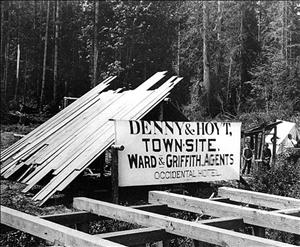This file contains Seattle historian and photographer Paul Dorpat's Now & Then photographs and reflections on the earliest extant photograph of Fremont, taken in 1888 by David Judkins.
Seattle's Fremont Neighborhood
We may take this 1888 photograph as an example of how many Seattle additions got their start. A developer purchases land from a homesteader, draws up a plat map marking streets, blocks, and lots and submits it to King County. It is not necessary to actually make streets or even to clear the land, but since the intention is to sell lots, it helps to find them. Naturally, it also helped if the original homesteader was a farmer who had alreadly pulled stumps for crops or stock.
The exact location recorded in this oldest surviving photograph of Fremont is hard to figure. I will speculate that the pioneer photographer, David Judkins, was perched on the Seattle, Lake Shore & Eastern Railroad trestle (now the Burke Gilman trail) near the Lake Union outlet. With his back to the lake, Judkins looks north to work-in-progress on the developer's real estate office.
This is almost certainly the oldest surviving photograph of any part of Fremont. It dates from sometime soon after March 20, 1888, when the site's second developers, Carrie and Edward Blewett, purchased acres to either side of Lake Union's outlet from the first developers, David Denny and John Hoyt.
These were known characters. Denny, of course, was one of Seattle's original pioneers, and Hoyt was a past governor of Idaho Territory as well as a Washington Territory Superior Court Justice. In 1887, Hoyt turned to banking and developing -- but only briefly here at the northwest corner of Lake Union. Soon after Hoyt sold these still wild acres to the Blewetts, the latter returned home to Fremont, Nebraska, and left the familiar Denny & Hoyt stamp on their new townsite.
For their agents, the Blewetts chose -- as the banner indicates -- Ward and Griffith. Luther Griffith, also from Fremont, Nebraska, became in his own right one of Seattle's "superdevelopers" of the 1890s. And he was soon joined by yet another Fremont Nebraskan, the dentist-developer Dr. E.C. Kilbourne. When a milling company settled at the outlet in the late summer of 1888, the milltown that sprang beside it was easily called Fremont. This was a naming convention repeated thousands of times throughout the West by mildly homesick Midwesterners and Europeans.
By 1890, Griffith and Kilbourne had built an electric trolley from Seattle to Fremont on a lakeshore trestle later filled in for Westlake Avenue. The following year Fremont was incorporated into Seattle. By then, of course, the forest screen backdrop to the ca. 1888 view had long since been replaced by the mill worker's modest homes, some of which still survive in Fremont.
As for the Now photo: In lieu of knowing the exact location of the historical Fremont photograph, I've substituted a record of its main intersection at the north end of the Fremont Bridge during the 1998 Fremont Fair.

